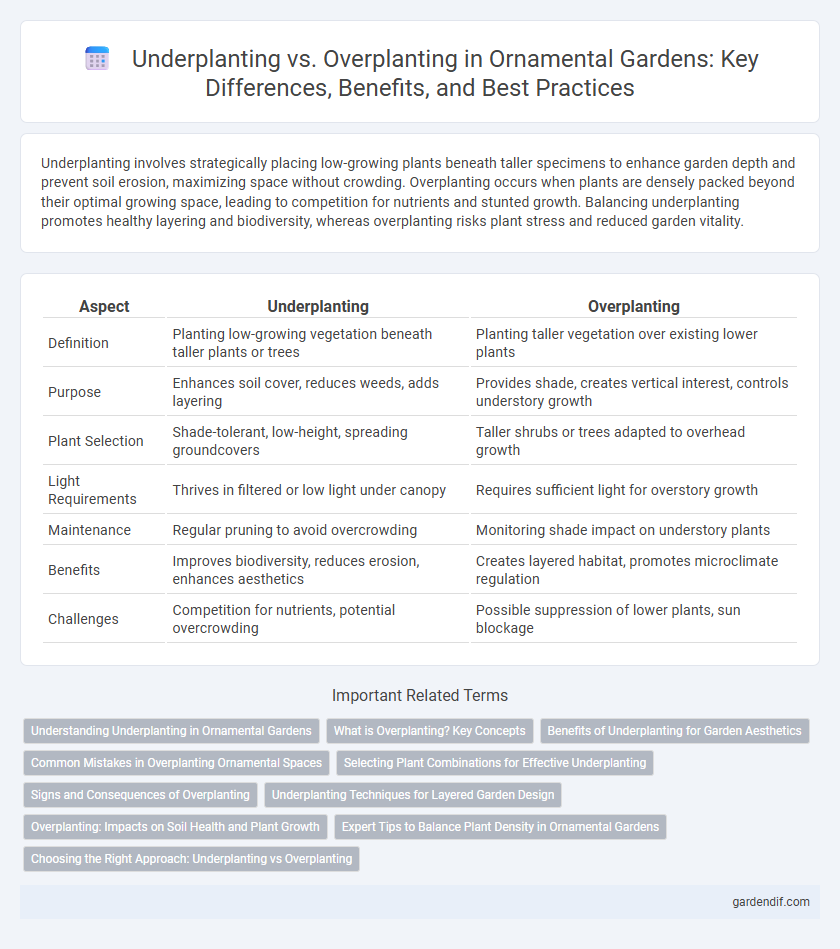
Underplanting vs Overplanting Illustration
Underplanting involves strategically placing low-growing plants beneath taller specimens to enhance garden depth and prevent soil erosion, maximizing space without crowding. Overplanting occurs when plants are densely packed beyond their optimal growing space, leading to competition for nutrients and stunted growth. Balancing underplanting promotes healthy layering and biodiversity, whereas overplanting risks plant stress and reduced garden vitality.
Table of Comparison
| Aspect | Underplanting | Overplanting |
|---|---|---|
| Definition | Planting low-growing vegetation beneath taller plants or trees | Planting taller vegetation over existing lower plants |
| Purpose | Enhances soil cover, reduces weeds, adds layering | Provides shade, creates vertical interest, controls understory growth |
| Plant Selection | Shade-tolerant, low-height, spreading groundcovers | Taller shrubs or trees adapted to overhead growth |
| Light Requirements | Thrives in filtered or low light under canopy | Requires sufficient light for overstory growth |
| Maintenance | Regular pruning to avoid overcrowding | Monitoring shade impact on understory plants |
| Benefits | Improves biodiversity, reduces erosion, enhances aesthetics | Creates layered habitat, promotes microclimate regulation |
| Challenges | Competition for nutrients, potential overcrowding | Possible suppression of lower plants, sun blockage |
Understanding Underplanting in Ornamental Gardens
Underplanting in ornamental gardens involves planting smaller, shade-tolerant species beneath larger shrubs or trees to create layered visual interest and maximize space utilization. This technique enhances biodiversity, improves soil health by reducing erosion, and supports pollinators by providing continuous bloom sequences. Carefully selecting compatible plant varieties ensures balanced growth and prevents overcrowding, which is common in overplanting scenarios.
What is Overplanting? Key Concepts
Overplanting refers to placing more plants in a given area than necessary, which can lead to competition for nutrients, water, and light. This practice often results in poor plant health, stunted growth, and increased susceptibility to pests and diseases. Effective overplanting management involves careful spacing, species selection, and ongoing maintenance to ensure optimal ornamental garden aesthetics and plant vitality.
Benefits of Underplanting for Garden Aesthetics
Underplanting enhances garden aesthetics by creating depth and texture through layering plants of varying heights and colors, which fosters a natural, cohesive look. It improves soil health and moisture retention by providing ground cover, reducing weed growth, and supporting beneficial insects, resulting in a thriving ecosystem. Strategically placed underplants complement focal plants, enriching visual interest without overwhelming the design, and extending seasonal appeal with diverse bloom times.
Common Mistakes in Overplanting Ornamental Spaces
Overplanting in ornamental garden spaces often leads to overcrowding, which restricts airflow and increases susceptibility to diseases such as powdery mildew and root rot. Common mistakes include planting incompatible species too close together and neglecting the mature size of plants, resulting in excessive competition for light, nutrients, and water. Proper spacing and selecting plants with complementary growth habits are essential to maintain plant health and visual appeal in ornamental landscapes.
Selecting Plant Combinations for Effective Underplanting
Selecting plant combinations for effective underplanting involves choosing species with complementary growth habits, light requirements, and root depths to maximize garden space and promote healthy plant coexistence. Shade-tolerant ground covers or low-growing perennials, such as hostas or ferns, work well beneath taller shrubs, enhancing soil moisture retention and suppressing weeds. Prioritizing plants with staggered bloom times and varying textures enriches visual interest while ensuring each layer thrives without competition for nutrients.
Signs and Consequences of Overplanting
Overplanting in ornamental gardens causes overcrowding, leading to poor air circulation and increased susceptibility to pests and diseases. Signs include stunted growth, yellowing leaves, and reduced flowering due to competition for nutrients, water, and light. Consequences often involve higher maintenance costs and the need for frequent thinning or replacement to restore plant health and aesthetic balance.
Underplanting Techniques for Layered Garden Design
Underplanting techniques in layered garden design involve strategically placing lower-growing plants beneath taller shrubs or trees to create depth and enhance visual interest. This approach maximizes space utilization, promotes biodiversity, and helps maintain soil moisture while adding textural contrast with diverse foliage and seasonal blooms. Effective underplanting requires selecting shade-tolerant species with complementary growth habits to ensure sustainable layered aesthetics and healthy plant communities.
Overplanting: Impacts on Soil Health and Plant Growth
Overplanting in ornamental gardening intensifies competition for essential nutrients, water, and sunlight, leading to stressed plants and reduced growth rates. This practice often depletes soil nutrients rapidly, disrupting microbial balance and diminishing soil fertility over time. Compacted soil from excessive root density impairs aeration and water infiltration, further compromising plant health and overall landscape vitality.
Expert Tips to Balance Plant Density in Ornamental Gardens
Expert tips for balancing plant density in ornamental gardens emphasize choosing underplanting to enhance biodiversity and improve soil health without overwhelming focal plants. Careful spacing and selection of shade-tolerant species prevent competition and ensure optimal growth, while avoiding overplanting reduces risks of disease and nutrient depletion. Incorporating layered planting strategies promotes visual depth and sustainability, optimizing aesthetics and garden vitality.
Choosing the Right Approach: Underplanting vs Overplanting
Choosing the right approach between underplanting and overplanting depends on the specific ornamental garden goals and site conditions. Underplanting focuses on layering plants beneath existing trees or shrubs, enhancing biodiversity and soil health while minimizing space use. Overplanting involves planting densely to establish quicker coverage and outcompete weeds but may require management to prevent overcrowding and ensure long-term plant health.
Underplanting vs Overplanting Infographic

 gardendif.com
gardendif.com